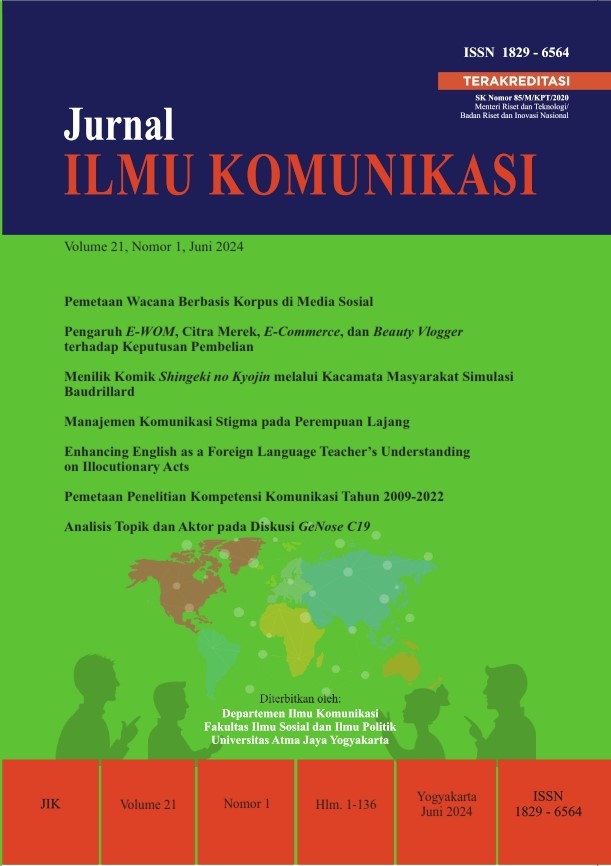Manajemen Komunikasi Stigma pada Perempuan Lajang
DOI:
https://doi.org/10.24002/jik.v21i1.8790Keywords:
communication management, spinster, stigmaAbstract
The patriarchal and collective culture necessitates women to marry at a certain age, or else they face various stigmas. Women need strategies to deal with these stigmas. This study aims to uncover the Stigma Management Communication (SMC) among single adult women, including their backgrounds and strategies in dealing with stigma. This research is qualitative research with multiple-case study method. Data was collected through interviews with women over 25 years old who currently have a job. Based on Meisenbach's concept of SMC, the results show that SMC is performed differently, such as ignoring, accepting, or confirming according to their individual situations.
References
Andu, C. P. (2019). Makna pernikahan bagi wanita lajang usia dewasa. Representamen, 5(1), 48-55.
Benokraitis, N. V. (2015). Marriages & families: Chance, choices & constraints (8 ed.). New Jersey, AS: Prentice Hall.
Creswell, J. W., & Creswell, J. D. (2018). Research design qualitative, quantitative, and mixed methods approaches (Fifth Ed). California, USA: SAGE.
D. W. S., F. P. (2018). Psychological well-being wanita dewasa lajang (ditinjau dari empat tipe wanita lajang menurut Stein). Jurnal Motiva, 28–37.
Fidaus, F. F., & Adha, G. (2022). Analisis saham YG Entertainment terhadap kasus burning sun dalam kondisi ekonomi. Sanskara Ekonomi dan Kewirausahaan, 01(01), 15–21.
Frelians, P. P., & Perbawaningsih, Y. (2020). Media sosial ruang Dayak dalam mereduksi stigma kebudayaan Dayak. Jurnal Ilmu Komunikasi, 18(2), 181-193.
Giawa, A., Siti Salmaniah Siregar, N., & Ideyani Vita, N. (2022). Stigma komunikasi negatif pada pasien ODHA (orang dengan HIV dan AIDS) Yayasan Medan Plus di Kota Medan. Ilmu Komunikasi (JIPIKOM), 4(1), 1–7.
Goffman, E. (1963). Stigma: Notes on the management of spoiled identity. New Jersey, AS: Prentice Hall.
Goffman, E. (2018). Stigma and social identity. In Rainwater, L. (2018). Deviance and liberty: Social problems and public policy. Oxfordshire, UK: Routledge.
Intan, T., & Machdalena, S. (2021). Stigma perempuan lajang dan perkawinan dalam metropop 90 hari mencari cinta karya Ken Terate. Mabasan, 15(1), 145–164.
Kamus Besar Bahasa Indonesia. (2023). Definisi stigma. https://kbbi.web.id/stigma. Jakarta, Indonesia: Badan Pengembangan dan Pembinaan Bahasa.
Kawahe, M., Lamadirisi, M., & Salem, V.E. (2021). Stigma sosial masyarakat di Desa Liwutung Kabupaten Mitra terhadap pasien covid-19. Indonesian Journal of Social Science and Education, 1(2), 118-125.
Lehmiller, J. J. (2014). The psychology of human sexuality. London, UK: Willey Blackwell.
Loynd, J. (2022). Exploring the correlates between gender and the stigma connected oaw enforcement personnel seeking/accepting treatment for mental health issues. Master's thesis, Massachusetts, USA: University of Massachusetts Lowell.
Meisenbach, R. J. (2010). Stigma management communication: A theory and agenda for applied research on how individuals manage moments of stigmatized identity. Journal of Applied Communication Research, 38(3), 268–292.
Meisenbach, R. J., & Roscoe, R. A. (2022). Stigma management. The international encyclopedia of health communication. New Jersey, AS: Wiley.
Meriam-Webster. (2019). Definition: stigma. https://www.merriam-webster.com/dictionary/stigma. Springfield, Massachusetts: G & C Merriam Co.
Neuman, W. L. (2014). Social research methods: Qualitative and quantitative approaches. Essex, UK: Pearson Education.
Noltensmeyer, C. J., & Meisenbach, R. J. (2016). Emerging patterns of stigma management communication strategies among burn survivors and relational partners. American Behavioral Scientist, 60(11), 1378–1397.
Nurhikmah, Taibe, P., & Zubair, A. G. H. (2022). Gambaran psychological well-being pada wanita dewasa madya lajang bersuku Bugis. Jurnal Psikologi Karakter, 2(1), 95–106.
O’Shay-Wallace, S. (2019). We weren’t raised that way: Using stigma management communication theory to understand how families manage the stigma of substance abuse. Health Communication, 35(4), 465–474.
Pratiwi, D., & Perdana, A. S. (2019). Circuit of culture: Advocating suicide prevention and eradication of mental illness associated stigma through ‘Into the Light Indonesia’ campaign. Expose: Jurnal Ilmu Komunikasi, 2(2), 191-212.
Ranjit, Y. S., Das, M., & Meisenbach, R. (2022). COVID-19 courtesy stigma among healthcare providers in india: A study of stigma management communication and its impact. Health Communication, 38(13) 1-10.
Risti, A. N., Hadisiwi, P., & Prihandini, P. (2022). Pengalaman komunikasi mahasiswi bercadar dalam menghadapi stigma masyarakat. Jurnal Manajemen Komunikasi, 6(2), 221-245.
Samovar, L. A., Porter, R. E., & McDaniel, E. R. (2017). Communication between cultures. Boston, MA: Cengage Learning.
Silverio, S. A., & Soulsby, L. K. (2020). Turning that shawl into a cape: Older never married women in their own words–the ‘pinsters’, the ‘singletons’, and the ‘superheroes.’ Critical Discourse Studies, 17(2), 211–228.
Smith, R. A., & Bishop, R. E. (2019). Insights into stigma management communication theory: Considering stigmatization as interpersonal influence. Journal of Applied Communication Research, 47(5), 571–590.
Suryana, A.F. & Supratman, L.P. (2021). Komunikasi intrapersonal ibu single parent dalam menghadapi stigma perceraian. eProceedings of Management Telkom University, 8(3), 1-7.
Wahdiniwaty, R., & Rustam, D. A. (2019). Patriarchy as a barrier to women entrepreneurs in Indonesia. IOP Conference Series: Materials Science and Engineering, 662(3), 1-4.
Yusof, F., & Mustafar, F. W. (2017). Cabaran bujang lewat usia: Stigma terhadap wanita berkerjaya. Jurnal Sains Sosial, 1(2), 117–129.
Downloads
Published
How to Cite
Issue
Section
License

This work is licensed under a Creative Commons Attribution 4.0 International License.
Jurnal ILMU KOMUNIKASI is an academic journal. As such, it is dedicated to the open exchange of information. For this reason, JIK is freely available to individuals and institutions. Authors who publish in Jurnal ILMU KOMUNIKASI will release their articles under the Creative Commons Attribution (BY) License. This license allows anyone to copy and redistribute the article in any medium or format as well as remix, transform, and build upon the material for any purpose, even commercially as long as they credit the authors for the original creation. For details of the rights authors grants users of their work, see the "human-readable summary" of the license, with a link to the full license. (Note that "you" refers to a user, not an author, in the summary)
 This work is licensed under a Creative Commons Attribution 4.0 International License.
This work is licensed under a Creative Commons Attribution 4.0 International License.














